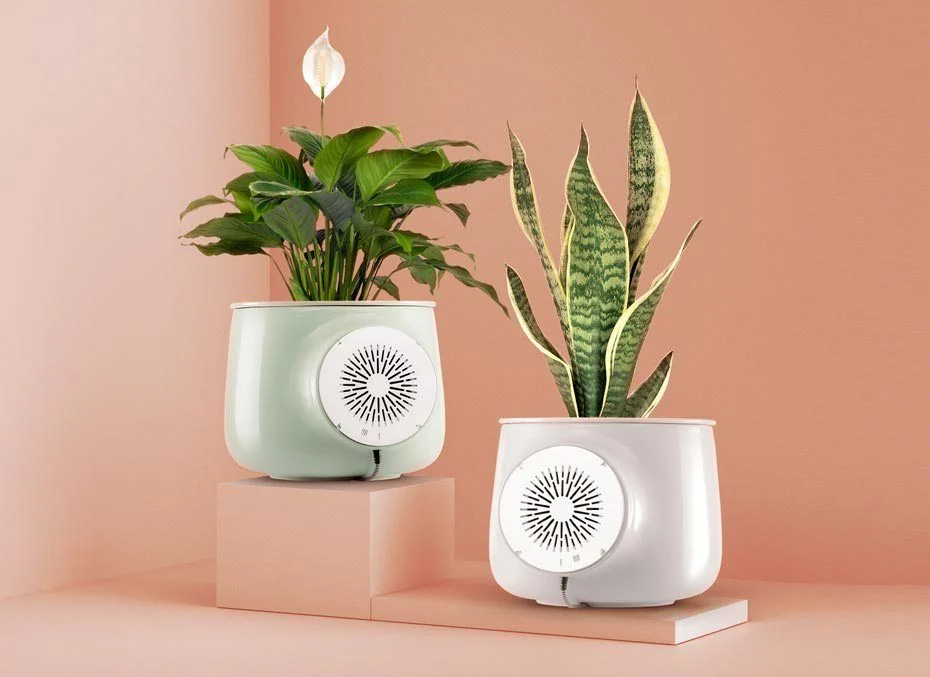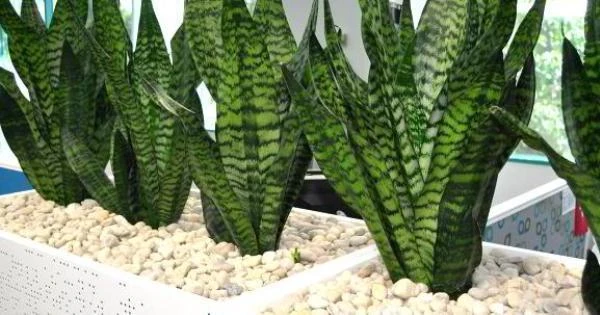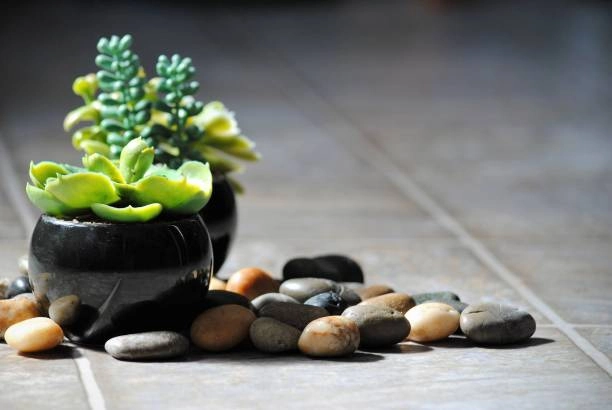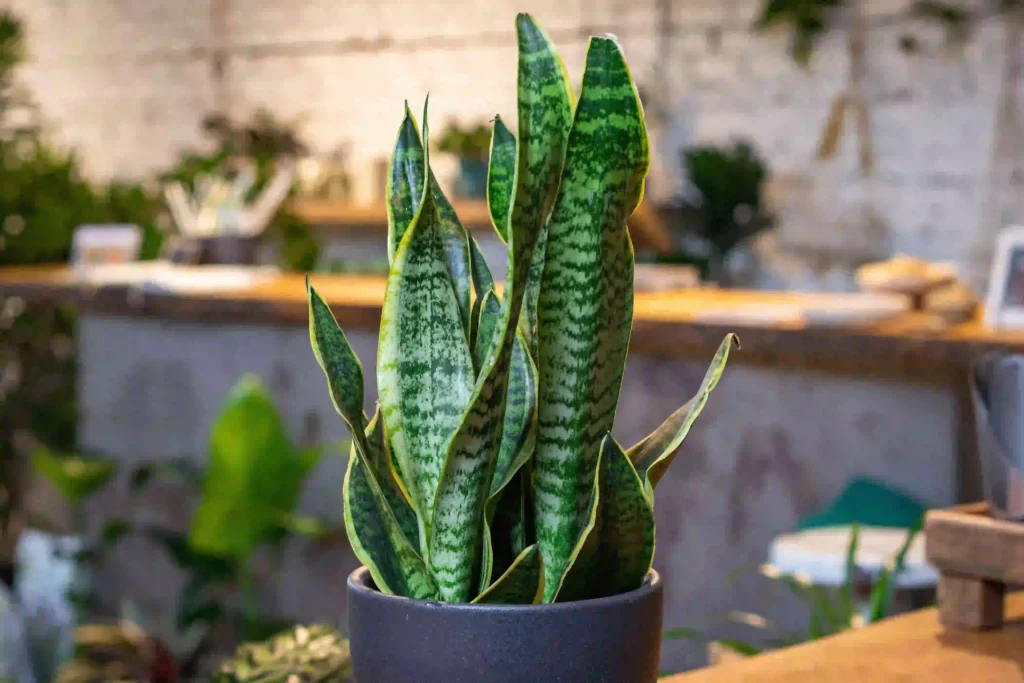You know those rare houseplants that somehow feel both effortless and meaningful? The snake plant — or Sansevieria trifasciata, if you want to sound fancy — is one of them. The more you learn about it, the more it feels like this quiet little wellness secret sitting in plain sight. From improving indoor air to brightening dull corners, the 10 benefits of snake plant reach far beyond just looks.
NASA even backed it up in their Clean Air Study, naming it among the best air-purifying plants that can filter toxins like formaldehyde and benzene — all while producing oxygen at night. That’s right, it’s working while you sleep. Whether you call it Mother-in-law’s Tongue or Dracaena trifasciata, this resilient succulent is a house favorite for good reason.
It doesn’t ask much: low light, minimal watering, no drama. But what it gives in return — cleaner air, calmer moods, a little spiritual balance if you’re into Feng Shui — makes it something more than décor. It’s like a living reminder that simple things can quietly ruined life better.
1. 🌱 The Science Behind the Snake Plant

So before diving into the actual benefits of snake plant for home and health, it helps to understand why it works the way it does.
🧬 What Is a Snake Plant (Sansevieria trifasciata)?
Native to West Africa, the snake plant thrives where other plants would give up — dry soil, low light, maybe a bit of neglect. It’s part of the Dracaena genus now (formerly Sansevieria), sharing family ties with Dracaena draco, another hardy beauty. The upright, sword-like leaves aren’t just striking; they actually store water and filter dust, making it one of the toughest indoor plants you can own.
Common varieties you’ll spot in homes:
| Variety | Appearance | Best Feature |
| Laurentii | Green leaves with golden edges | Classic look, easy to find |
| Moonshine | Silvery-green leaves | Minimalist and modern |
| Cylindrica | Cylindrical, tall leaves | Great for corners and desks |
Each variation shares the same core qualities: durability, toxin absorption, and low upkeep — all of which tie directly into its health benefits.
🧪 NASA’s Research: Can Plants Really Purify Air?
Back in the late 1980s, NASA ran a Clean Air Study to explore how indoor plants could improve air quality aboard space stations. The results were surprisingly hopeful: snake plants removed toxins like benzene, trichloroethylene, xylene, and formaldehyde from sealed environments. That’s why experts often call it a natural air purifier — one that doesn’t hum, buzz, or need a filter change.
But there’s a fun twist — while most plants sleep at night, snake plants continue to release oxygen through a process called Crassulacean Acid Metabolism (CAM). Basically, it opens its pores at night to absorb carbon dioxide and convert it into oxygen — a rare trick among indoor plants.
Pro Tip: Keep one near your bed or desk — it subtly improves air quality where you spend the most time breathing in recycled indoor air.
2. 🌬️ Benefit #1: Purifies Indoor Air Naturally
Let’s be honest — we underestimate how “dirty” indoor air can get. Between cooking fumes, furniture off-gassing, cleaning sprays, and the occasional candle obsession, your home quietly collects a mix of airborne toxins. And this is where the snake plant quietly becomes your unsung hero.

Unlike artificial air purifiers, this leafy friend doesn’t need electricity or filter replacements. The 10 benefits of snake plant for home and health start right here — it’s a natural detox system for your indoor space. Studies, including NASA’s Clean Air Study, found that snake plants can absorb harmful volatile organic compounds (VOCs) like formaldehyde, benzene, and trichloroethylene — the same stuff found in paints, synthetic fabrics, and cleaning products.
🧾 How It Works
Snake plants are equipped with microscopic pores called stomata that open to pull in pollutants. They metabolize these compounds and release fresh oxygen in exchange. So basically, while you go about your day (or night), this hardy succulent is quietly filtering your air.
Here’s a quick comparison:
| Feature | Snake Plant | Typical Air Purifier |
| Power Source | None (natural) | Electricity |
| Maintenance | Minimal (wipe leaves) | Filter replacement |
| Removes VOCs | ✅ Yes | ✅ Yes |
| Releases Oxygen | ✅ Constantly | ❌ No |
| Aesthetic Value | ✅ Decorative | ❌ Functional only |
So, while it’s not a replacement for a good ventilation system, it’s a wonderful supplement — especially if you live in urban settings with limited outdoor airflow.
Pro Tip: Place one snake plant in every 100 square feet of living space. For bedrooms or offices, that’s roughly one medium-sized plant per room to noticeably improve indoor air quality.
3. 🌙 Benefit #2: Boosts Oxygen Levels at Night

Here’s something fascinating — most plants only release oxygen during the day. But the snake plant? It’s got a night shift. Thanks to a special process called Crassulacean Acid Metabolism (CAM), it actually continues oxygen production after sunset.
When you think about it, that makes the benefits of snake plant for home and health particularly valuable in bedrooms. While you sleep, it quietly absorbs carbon dioxide and converts it into oxygen, helping maintain fresher, cleaner air overnight.
Ever wake up feeling groggy, even after a full night’s rest? Poor indoor air quality could be part of the problem. Low oxygen and trapped carbon dioxide in sealed rooms can make mornings feel heavier. The snake plant’s nighttime photosynthesis helps counteract that — a subtle but real boost to your sleep environment.
🌿 Where to Place It
To make the most of this nocturnal benefit:
- Keep one near your bedside table or window ledge (they like some indirect light).
- Avoid overwatering — soggy roots can cause rot, reducing the plant’s oxygen efficiency.
- Mix it with other bedroom-friendly plants like peace lilies or aloe vera for even better air balance.
Mini Table: Nighttime Oxygen Boosters
| Plant | Oxygen Activity | Best Placement |
| Snake Plant (Dracaena trifasciata) | 🌙 Active at Night | Bedroom corners |
| Aloe Vera | 🌙 Active at Night | Window ledge |
| Areca Palm | ☀️ Daytime only | Living room |
| Peace Lily | ☀️ Daytime only | Hallway or dining area |
Pro Tip: If you’re someone who struggles with insomnia or stuffy air at night, pairing a snake plant with good ventilation (cracked window, small fan) can create a surprisingly noticeable improvement in sleep quality.
4. 💚 Benefit #3: Reduces Stress and Boosts Mental Clarity
You’ve probably noticed how just seeing greenery can calm you a little — maybe not dramatically, but in this quiet, grounding way. That’s not a coincidence; it’s biophilic design at work. Humans are wired to feel better around nature, and having a snake plant around taps into that instinct beautifully.
Among the 10 benefits of snake plant for home and health, this one is less about science experiments and more about the subtle, emotional science of space. When your eyes catch that upright green form, your brain registers calm. Studies in workplace psychology show that employees surrounded by indoor plants experience less stress, fewer headaches, and higher focus levels.
In short, it’s mental clarity, bottled in chlorophyll.
🌿 How the Snake Plant Supports Mental Health
The snake plant’s ability to improve indoor air quality isn’t just a physical perk — cleaner air directly influences mood, focus, and cognitive sharpness. Think of it like removing invisible clutter from your breathing space.
Here’s what happens psychologically:
- Cleaner air = reduced fatigue and brain fog.
- Visual greenery = calm nervous system, lower cortisol.
- Subtle oxygen increase = better cognitive flow.
Whether you place it in a home office, a study corner, or a meditation nook, the Sansevieria trifasciata acts like a quiet co-worker that never complains — just breathes with you.
Pro Tip: Combine snake plants with warm-toned décor or natural wood elements. The Feng Shui principle says pairing green (wood element) with earth tones helps stabilize emotional energy — perfect for workspaces or reading corners.
5. 🌵 Benefit #4: Low Maintenance & Beginner-Friendly
If you’ve ever killed a plant (or three), this one’s for you. The snake plant might be the closest thing to an indestructible houseplant you’ll find. It’s practically made for busy people, travelers, or, honestly, anyone who forgets watering schedules.
This resilient succulent thrives on neglect — and that’s part of why it’s among the top benefits of snake plant for home and health. It adjusts to almost any indoor condition: bright light, shade, dry air, and recycled office environments. As long as you don’t overwater it, it’ll just keep standing tall.
🌼 What Makes It So Easy
| Feature | Snake Plant Advantage | Ideal for |
| Light Needs | Tolerates low to bright indirect light | Apartments, offices |
| Watering | Every 2–3 weeks (less in winter) | Forgetful owners |
| Humidity | Handles dry indoor air easily | Air-conditioned rooms |
| Soil Type | Well-draining cactus mix | Beginners |
| Propagation | Simple — via leaf cuttings or root division | DIY plant lovers |
In fact, propagation is part of the fun. You can snip a leaf, let it callous for a few days, then stick it in soil or water — and voila, new life. This kind of plant propagation not only saves money but makes your home feel naturally abundant.
And because it’s resistant to most indoor air pollutants, it stays fresh longer with minimal intervention. Just wipe the leaves occasionally to remove dust — that’s pretty much its version of a spa day.
Pro Tip: Avoid using decorative pots without drainage holes. Snake plants are prone to root rot if left sitting in soggy soil. Choose breathable containers like terracotta or ceramic, especially if your space is humid.
6. 🌫️ Benefit #5: Natural Humidifier & Allergy Relief
You know that tight, dry feeling you get when indoor air feels stale — especially after running the heater or air conditioner too long? The snake plant quietly helps balance that out. While it’s not a traditional humidifier, its slow release of moisture through transpiration can subtly improve the indoor air quality around you.
That small, steady moisture boost can make a surprising difference if you’re sensitive to house allergens or struggle with respiratory issues. Dry air often worsens sinus congestion, itchy throats, and airborne allergies. Snake plants help stabilize humidity and even filter dust and airborne particles, which can be a small but meaningful relief for anyone living in polluted or air-conditioned spaces.
🌬️ How the Snake Plant Helps You Breathe Easier
| Concern | How Snake Plant Helps | Extra Benefit |
| Dry indoor air | Gentle moisture release | Less throat irritation |
| Dust accumulation | Broad leaves trap particles | Cleaner indoor surfaces |
| Allergens & pollutants | Absorbs toxins like benzene, formaldehyde | Fewer respiratory triggers |
| Low oxygen levels | Oxygen production via CAM | Fresher night air |
Basically, it’s like having a living air filter that never needs a plug or battery.
Pro Tip: For people prone to seasonal allergies, pair your snake plant with natural air purifiers like peace lilies or bamboo palms. Together, they create a mini indoor ecosystem that filters toxins and balances humidity — without introducing artificial fragrances that can trigger sensitivities.
Quick Note: While snake plants help with airborne allergens and toxins, they don’t replace good ventilation. Crack open a window occasionally — even five minutes can make a difference.
7. 🌙 Benefit #6: Enhances Sleep Quality
It’s kind of poetic how this plant works hardest when you’re resting. The snake plant, thanks to its Crassulacean Acid Metabolism (CAM) process, continues oxygen production throughout the night — making it one of the best bedroom air-purifying plants for better sleep.
Most houseplants “rest” at night, meaning they stop releasing oxygen. But snake plants? They stay on duty, absorbing carbon dioxide and releasing oxygen while you sleep. The result is air that feels fresher, lighter — and you, waking up feeling clearer and less groggy.
💤 Why Snake Plants Belong in Your Bedroom
- Improved air quality → Reduces stuffiness and fatigue.
- Steady oxygen release → Supports deeper, more restful sleep.
- Natural toxin absorption → Helps neutralize indoor pollutants from paint or furniture.
- Quiet energy balance → In Feng Shui, it’s believed to dispel bad energy while promoting calm.
Here’s a quick comparison of snake plant bedroom benefits vs other indoor plants:
| Plant | Nighttime Oxygen | Maintenance | Best for |
| Snake Plant | ✅ High | Low | Sleep support, clean air |
| Aloe Vera | ✅ Moderate | Moderate | Skin + air benefits |
| Peace Lily | ❌ Daytime only | Moderate | Moisture balance |
| Areca Palm | ❌ Daytime only | Moderate | Large spaces |
So yes — it’s safe to keep snake plants in your bedroom. In fact, it’s one of the simplest ways to make your sleeping space feel fresher and a little more peaceful.
Pro Tip: If your bedroom tends to feel heavy or “stale,” position your snake plant near a slightly open window or on your nightstand. The gentle airflow helps it circulate oxygen more effectively — plus, waking up beside something green feels oddly grounding.
8. 🌸 Benefit #7: Adds Natural Décor & Positive Energy (Feng Shui)

You ever notice how some plants just change the feeling of a room? The snake plant has that kind of quiet presence — tall, balanced, and effortlessly confident. According to Feng Shui principles, its upright, blade-like leaves symbolize strength and protection. Some even say it wards off bad energy and keeps the room’s chi — the natural life force — flowing cleanly.
From a design perspective, it’s a minimalist dream. The benefits of snake plant for home and health don’t end with cleaner air; they extend into how your space feels. Its sharp lines and deep greens fit perfectly in modern interiors — Scandinavian, boho, rustic, or industrial. It complements wood elements beautifully and brings that pop of green that makes neutral spaces feel alive again.
🪴 Why Designers Love It
| Aesthetic Benefit | Why It Works | Design Tip |
| Sleek, upright form | Adds height and visual balance | Place near entryways or windows |
| Evergreen leaves | Year-round freshness | Great for minimal interiors |
| Versatile potting styles | Adapts to ceramic, rattan, or concrete pots | Match to décor palette |
| Symbolic energy | Represents growth, protection, and resilience | Perfect for meditation rooms |
In Feng Shui, placing a snake plant near the front door or southeast corner of your home is believed to attract wealth energy while deflecting negativity. Whether you believe in energy flow or not, the truth is simpler — it feels grounding to come home to something that quietly thrives.
Pro Tip: If you’re styling your home office or bedroom, group the snake plant with soft textures (like linen curtains or jute rugs). The hard, structural shape of its leaves balances beautifully against natural fibers — a subtle harmony of elements that instantly softens the vibe.
9. 🌎 Benefit #8: Supports Sustainable & Eco-Friendly Living
In an age of plastic plants and artificial greenery, the snake plant is like a quiet reminder that real things age beautifully. It’s one of the most eco-friendly home plants you can own — durable, long-living, and incredibly resource-efficient.
Unlike many decorative plants that require constant care, fertilizers, or humidity control, the snake plant thrives on minimal input. That means less water, fewer chemical products, and almost no waste — a tiny contribution toward sustainable indoor gardening and mindful consumption.
🌱 Why It’s Considered an Eco Hero
- Low resource demand – Survives in poor soil and minimal light.
- Natural air purifier – Filters toxins like benzene and formaldehyde, improving indoor air quality.
- Long lifespan – Can live for years with basic care, reducing plant waste.
- Easy propagation – Grows new plants through leaf cuttings or root division, no need to buy replacements.
- Biodegradable material – At the end of its life, it naturally decomposes — no artificial residue.
Quick Comparison: Eco-Friendliness of Popular Houseplants
| Plant | Water Use | Longevity | Air Purifying Ability | Eco Impact |
| Snake Plant | Very Low | 5–10 years | High | Excellent |
| Peace Lily | Moderate | 2–3 years | High | Moderate |
| Spider Plant | Moderate | 3–5 years | Moderate | Good |
| Fiddle Leaf Fig | High | 2–3 years | Low | Poor |
What’s more — owning plants like these naturally encourages sustainable habits. You start composting, reusing pots, or collecting rainwater without even realizing it. That’s how green living often begins — with one small, resilient succulent sitting quietly by your window.
Pro Tip: If you’re buying new plants, look for local plant nurseries or online eco-conscious sellers like Unlimited Greens that promote sustainable growing practices. Locally sourced plants adapt better to your climate and have a lower carbon footprint than imported ones.
10. 🧠 Benefit #9: Improves Concentration & Productivity
Let’s be honest — it’s hard to stay focused when your workspace feels dull or cluttered. But here’s where the snake plant quietly shines again. Studies show that adding plants for productivity to your desk or room can significantly reduce stress levels, boost focus, and even lower fatigue.
The benefits of snake plant for home and health extend into your work life, too. Its deep green foliage creates a calming visual cue that helps your mind reset. That’s why many psychologists recommend adding greenery to study or work environments — it promotes a quiet, grounded energy.
🌿 How Snake Plants Help You Stay Sharp
- Purifies air around your workspace → Cleaner oxygen means sharper thinking.
- Reduces stress at work → Calming natural presence reduces anxiety.
- Improves humidity balance → Prevents dry eyes and throat from long hours indoors.
- Boosts creativity & attention span → Greenery stimulates positive cognitive responses.
- Low-maintenance → No watering distractions during busy weeks.
| Setting | Benefit | Placement Idea |
| Home Office | Boosts productivity & mental clarity | On your desk corner |
| Study Room | Improves memory retention | Near bookshelves |
| Living Room | Reduces visual clutter | Beside the TV unit |
| Corporate Office | Calms stressful environments | Shared tables or reception |
Pro Tip: For maximum focus, place your snake plant about 3 feet away from where you sit. That distance keeps oxygen circulation optimal without cluttering your workspace visually. Pair it with good natural light — your brain thrives when your space “feels alive.”
11. 🧴Benefit #10: Acts as a Natural Home Detoxifier

If you’ve ever noticed that indoor air sometimes feels heavier than outdoor air, you’re not wrong. Most homes are filled with volatile organic compounds (VOCs) — invisible chemicals released from paint, furniture, plastics, and cleaning products. This is where the snake plant steps in as a powerful home detox plant.
NASA’s Clean Air Study famously identified the snake plant as one of the top air purification plants capable of removing toxins like formaldehyde, xylene, benzene, and trichloroethylene. These are common in homes, yet long-term exposure can cause fatigue, dizziness, or headaches.
🧪 Common Indoor Pollutants & How Snake Plant Neutralizes Them
| Pollutant | Source | Snake Plant Action | Health Benefit |
| Formaldehyde | Furniture, carpets | Absorbs & converts | Reduces headaches, irritation |
| Benzene | Paints, plastics | Breaks down via leaves | Lowers fatigue risk |
| Xylene | Cleaning products | Filters via pores | Supports healthy respiration |
| Toluene | Adhesives | Absorbs airborne toxins | Improves focus, prevents dizziness |
This makes the benefits of snake plant for home and health particularly valuable in modern apartments where ventilation is limited. Even one or two medium-sized plants can make a measurable difference in air freshness and toxin absorption.
Pro Tip: Want to supercharge the detox effect? Combine your snake plant with peace lilies and Boston ferns. This trio creates a multi-layered defense system against VOCs while enhancing humidity and overall air purification benefits.
12. 🌿 Benefit #11: Low Maintenance & Beginner-Friendly
Here’s one of the biggest reasons people fall in love with the snake plant — it practically takes care of itself. For anyone new to plant parenting, this is a dream come true. It’s one of the best low-maintenance indoor plants you can own, thriving in neglect, low light, or even after you forget to water it for weeks.
Unlike fussy tropical plants, the snake plant has succulent-like foliage that stores water in its thick, sword-shaped leaves. That means you can travel, get busy, or simply forget — and it’ll still be standing strong when you return.
🌱 What Makes It So Easy to Care For
- Drought-tolerant houseplant — Water only when the soil feels dry.
- Thrives in low or bright light — Great for offices, bedrooms, or shaded corners.
- Adapts to neglect — Minimal feeding, no daily misting needed.
- Resistant to pests & diseases — Rarely attracts bugs or mold.
- Forgiving of repotting errors — It prefers being slightly root-bound.
| Care Factor | Requirement | Frequency |
| Watering | Once every 2–3 weeks | Check soil dryness first |
| Light Exposure | Low to bright indirect light | Avoid harsh sun |
| Fertilizing | Mild succulent fertilizer | Every 2–3 months |
| Cleaning | Wipe leaves with damp cloth | Monthly |
| Pruning | Remove yellow leaves | As needed |
The benefits of snake plant for home and health go hand-in-hand with how effortlessly it fits modern life — clean, stylish, and almost indestructible.
Pro Tip: Overwatering is the only real mistake people make. Always use a well-draining pot (like terracotta) and avoid letting roots sit in water. Think of it as “less is more” care — the plant loves to be left alone.
13. 🐾 Benefit #12: Pet Safety & Handling Tips
Here’s something every pet lover should know: while the snake plant is amazing for air purification and home aesthetics, it’s mildly toxic to cats and dogs if chewed. The plant contains saponins — natural compounds that can cause nausea or vomiting in pets.
Now, don’t panic. It’s rarely fatal, and most pets instinctively avoid the bitter taste. Still, awareness helps you maintain both a pet-safe home décor and a healthy environment.
🐶 Is the Snake Plant Safe for Pets?
| Pet Type | Risk Level | Reaction | Prevention Tip |
| Cats | Mild to moderate | Drooling, nausea | Keep out of reach — shelves or tall stands |
| Dogs | Mild | Occasional vomiting | Train “leave it” command |
| Small Pets (rabbits, hamsters) | Mild | Digestive irritation | Avoid placing inside cages |
The benefits of snake plant for home and health still outweigh this concern, as long as you’re mindful of placement. Use tall planters or hanging baskets in pet-friendly homes.
🪴 Safer Alternatives for Pet Owners
If you want non-toxic houseplants with similar beauty and air-purifying abilities, consider:
- Areca Palm – Great oxygen booster and safe for pets.
- Spider Plant – Easy to grow, air-purifying, totally non-toxic.
- Parlor Palm – Adds greenery without risk.
- Calathea – Gorgeous foliage and safe for cats and dogs.
Pro Tip: Spray a light mist of citrus essential oil (pets dislike the scent) around your snake plant base to discourage chewing — but never apply it directly on the leaves.
14. 🌿 Benefit #13: Cultural & Historical Significance of the Snake Plant

The snake plant isn’t just another air-purifying houseplant — it’s a plant steeped in history, symbolism, and meaning. Across Africa and Asia, this resilient succulent has been valued for centuries, both spiritually and practically.
In West Africa, for instance, it’s often associated with Ogun, the deity of strength and protection. The Mother-in-law’s tongue meaning (as it’s sometimes called) comes from its sharp, upright leaves — symbolizing truth, resilience, and clear communication. In Chinese culture, it’s known as the “Plant of Good Fortune”, believed to attract prosperity, protection, and health energy.
| Culture | Symbolism | Common Belief |
| African | Strength, protection | Sacred plant for warding off bad energy |
| Chinese (Feng Shui) | Prosperity, purification | Brings balance and positive chi |
| Japanese | Longevity, endurance | Represents timeless strength |
| Western Homes | Modern minimalism | Sign of clean energy and simple living |
So when you bring a snake plant into your home, you’re not just improving air quality — you’re connecting with centuries of symbolism around healing, balance, and grounded energy.
🌿 Fun Fact
The snake plant’s botanical journey is fascinating — once classified as Sansevieria trifasciata, it’s now placed in the Dracaena genus. This update reflects its shared traits with other resilient succulents, like Dracaena draco, known for durability and air purification.
Pro Tip: To enhance Feng Shui energy flow, place your snake plant near entryways or hall corners — spaces where stagnant energy tends to collect. Its upright leaves act like protective swords, symbolically cutting through negativity.
15. 🏡 Benefit #14: Elevates Interior Aesthetics & Home Design
Let’s be honest — the benefits of snake plant for home and health aren’t just about air quality or wellness; it’s also about how stunning they look. With their tall, architectural leaves and clean lines, snake plants fit effortlessly into almost any aesthetic — modern, boho, minimalist, even rustic.
You’ve probably seen them in Instagram-perfect corners or designer showrooms — and for good reason. Their sculptural form adds structure and balance to a room without demanding attention. Whether tucked into a matte ceramic pot or paired with wooden tones, the snake plant brings that subtle sophistication people crave in biophilic interiors.
Here’s how different styles make the most of this beauty:
| Home Style | Best Placement | Visual Effect |
| Modern Minimalist | Corner of living room | Clean lines and balance |
| Bohemian Chic | Near woven furniture | Adds natural texture |
| Scandinavian | On window ledge or shelf | Complements neutral palettes |
| Rustic/Earthy | With clay or terracotta pots | Adds warmth and authenticity |
🌿 Quick Design Ideas
- Cluster three snake plants of varying heights for a bold visual statement.
- Pair with wood elements or white décor to highlight its green-gold leaves.
- Use leaf cuttings for propagation — they make small tabletop accents.
- Create a mini indoor plant corner with snake plants, spider plants, and peace lilies for a cohesive, air-purifying setup.
Pro Tip: Combine snake plants with softer foliage like ferns or pothos to balance their vertical shape. This creates a more relaxed, layered texture — perfect for cozy living rooms or bedrooms.
16. 🌿 Benefit #15: Promotes Wellness, Mental Clarity & Immune Health
You know how some spaces just feel better to be in? Like you walk in and something about the air — or the vibe — feels lighter? That’s part of the benefits of snake plant for home and health too. It’s not just aesthetic or air-related; it’s genuinely about how you feel living around greenery.
Multiple studies in environmental psychology suggest that indoor plants help lower stress hormones, improve mood, and even boost focus and memory retention. The snake plant (Dracaena trifasciata) does this beautifully — quietly purifying air, stabilizing humidity, and subtly encouraging your body to relax.
🧘 How the Snake Plant Supports Well-Being
| Wellness Area | How It Helps | Why It Works |
| Mental Health | Reduces anxiety & mental fatigue | Natural green tones calm the nervous system |
| Immune System | Filters indoor air pollutants | Fewer toxins → less immune strain |
| Sleep & Recovery | Releases oxygen at night | Better oxygenation aids cellular repair |
| Focus & Productivity | Enhances cognitive performance | Cleaner air = sharper mind |
It’s kind of poetic, really — a plant that just sits there quietly, yet it’s actively fighting off invisible pollutants, supporting your breathing, and nudging your mental state toward calm.
Pro Tip: Place a snake plant near your workspace or meditation corner. Its vertical lines subconsciously signal focus and strength, helping you anchor your thoughts. Pair it with soft lighting or wood textures for maximum grounding energy.
17. 🌱 How to Care for Your Snake Plant: Simple Guide for Long-Term Health
Now that we’ve covered nearly all 10 benefits of snake plant for home and health, let’s make sure you actually keep yours thriving. The good news? It’s one of the easiest indoor plants to maintain — even for total beginners.
Here’s a quick, realistic care guide that won’t overwhelm you:
🌞 Basic Care Checklist
- Light: Prefers bright, indirect sunlight but tolerates low light.
- Water: Let soil dry out between waterings — every 2–3 weeks is plenty.
- Soil: Use well-draining cactus or succulent mix.
- Temperature: Thrives between 60–85°F (16–29°C).
- Fertilizer: Feed every 2–3 months during spring and summer.
- Humidity: Average room humidity works fine.
| Common Problem | Likely Cause | Easy Fix |
| Yellowing Leaves | Overwatering | Let soil dry fully before watering again |
| Soft or Mushy Roots | Poor drainage (root rot) | Repot with gritty soil & use a pot with holes |
| Brown Tips | Too little humidity or fertilizer burn | Mist occasionally, dilute fertilizer |
| Stunted Growth | Low light or old soil | Move to brighter area & refresh potting mix |
🌿 Propagation Tips (Because Sharing is Caring)
- Leaf Cuttings: Cut a healthy leaf into 3-inch pieces, let them callous for 1–2 days, then place in moist soil.
- Root Division: Gently separate the root rhizomes and replant.
- Water Propagation: Place leaf sections in water until roots appear, then transfer to soil.
Pro Tip: To avoid root rot, use pots with drainage holes and water less during winter. Snake plants follow Crassulacean Acid Metabolism (CAM), so they breathe differently — less water is better than too much.
18. 🌿 Common Mistakes with Snake Plant Care (And How to Fix Them)
Even though the snake plant (Dracaena trifasciata) is famously low-maintenance, a few easy-to-miss mistakes can make it sulk — or worse, rot. So, before you call it quits, here’s a quick look at the most common slip-ups plant parents make and how to avoid them.
You’d be surprised how often people “love” their plants a bit too much — especially with water.
💧 Top Snake Plant Mistakes to Avoid
| Mistake | Why It Happens | Quick Fix |
| Overwatering | Mistaken belief that plants need frequent watering | Only water when soil is completely dry — about every 2–3 weeks |
| Poor Drainage | Decorative pots without holes trap moisture | Always use a well-draining pot; line decorative pots with a plastic insert |
| Too Much Direct Sunlight | Bright sun scorches leaves | Move to indirect light — snake plants thrive in medium light |
| Neglecting Repotting | Roots get cramped after 2–3 years | Gently repot in fresh succulent soil every 2 years |
| Cold Drafts or AC Exposure | Temperature shock damages foliage | Keep away from cold air vents or open windows in winter |
| Using Tap Water with Fluoride | Chemicals can discolor leaves | Let tap water sit overnight or use filtered water |
It’s not just about survival — it’s about giving your snake plant a healthy environment where it can thrive, filter toxins, and release oxygen at its best capacity. That’s the real secret behind the benefits of snake plant for home and health — consistency over perfection.
Pro Tip: If your snake plant’s leaves start curling or turning pale, don’t panic. It’s probably signaling light stress or root congestion. Trim damaged leaves and shift it to a stable, bright-but-indirect light zone — it usually bounces back within weeks.
19. 🏡 Creative Ways to Style Snake Plants in Your Home
Now, here’s where the snake plant becomes more than just a health booster — it turns into a statement piece. Styling this plant is easy, elegant, and adaptable to almost any interior. Whether you’re going for Feng Shui harmony, modern minimalism, or earthy boho aesthetics, there’s a way to make it look intentional and calming.
🌿 Styling Ideas for Every Room
- Entryway: Place a tall snake plant near the door to absorb bad energy and welcome guests with clean air.
- Bedroom: Use medium-sized snake plants on bedside tables — their nighttime oxygen release enhances sleep quality.
- Living Room: Group three plants of different sizes for a layered air purification zone.
- Bathroom: Small snake plants thrive in humidity — perfect for detoxing steam-filled air.
- Office or Study: Keeps mental clarity high while adding a natural décor accent.
| Room | Suggested Snake Plant Type | Purpose |
| Bedroom | Sansevieria Moonshine | Boosts oxygen & aids restful sleep |
| Living Room | Sansevieria Laurentii | Strong vertical shape, air purifying |
| Bathroom | Sansevieria Cylindrica | Handles humidity, low maintenance |
| Office | Dracaena trifasciata Compacta | Compact, focus-enhancing |
| Entryway | Mother-in-law’s Tongue | Feng Shui protector, cleanses energy |
Pro Tip: Mix textures. Pair your snake plant with woven baskets, clay pots, or ceramic planters to balance the sharp leaves with softer elements. If you love clean lines, opt for matte black or white pots for that sleek, minimalist vibe.
20. 🌿 DIY Snake Plant Propagation & Growth Hacks
One of the most satisfying parts of owning a snake plant is how easily it multiplies. Imagine turning one healthy plant into several — for free! Whether you’re a beginner or a houseplant pro, propagating this resilient plant is both simple and fun.
✂️ 3 Easy Ways to Propagate Snake Plant
| Method | Tools Needed | Best For | Time to Root |
| Leaf Cuttings (Water Method) | Sharp scissors, clean jar, water | Beginners | 4–6 weeks |
| Leaf Cuttings (Soil Method) | Succulent mix soil, pot, rooting hormone (optional) | Quick rooting | 5–7 weeks |
| Root Division | Mature snake plant, clean knife | Experienced growers | Immediate growth |
🌱 Step-by-Step: How to Propagate Snake Plant from Leaf Cuttings
- Choose a healthy, mature leaf.
- Cut it into 3–4 inch segments.
- Place the cuttings upright in a jar filled with filtered water.
- Keep in bright, indirect sunlight.
- Change the water weekly to avoid bacterial buildup.
- Once roots reach 1–2 inches, transfer to a pot with well-draining succulent soil.
💡 Pro Tip: When using the soil propagation method, always ensure the cut side faces down (the original root end). Planting it upside down will prevent rooting.
🌾 Growth Hack for Faster Results
Add a small amount of cinnamon powder to the cut edge before planting — it acts as a natural fungicide and encourages faster rooting. You can also mix a pinch of perlite and coco coir into your soil to boost aeration and moisture balance.
Propagation isn’t just about growing more plants — it’s about understanding how the snake plant thrives, which deepens your appreciation for the 10 benefits of snake plant for home and health in your living space.
Conclusion
When you look at the 10 benefits of snake plant, it’s clear why this humble green companion has become a must-have in modern homes. It purifies indoor air, boosts oxygen, and adds a peaceful kind of beauty that makes every room feel more balanced and alive. Its low-maintenance nature makes it perfect for busy lifestyles, thriving even when neglected. Honestly, it’s one of those rare plants that gives back more than it takes.
Beyond the science and wellness perks, the snake plant also brings subtle comfort — a sense of calm energy that reminds you to slow down, breathe deeper, and reconnect with nature right where you are. It’s more than décor; it’s a quiet reminder that wellness can grow in the simplest corners of your home.
Frequently Asked Questions
1. Is the snake plant really good for indoor air?
Yes, absolutely. Snake plants are known to filter toxins like formaldehyde and benzene, helping to keep your indoor air fresher and easier to breathe. It’s like having a quiet air purifier that never needs plugging in.
2. Can I keep a snake plant in my bedroom?
Definitely! Since it releases oxygen at night, it’s one of the best plants for bedrooms — ideal for better sleep and calmer energy. Plus, it adds a relaxing touch to your nighttime space.
3. How often should I water my snake plant?
Honestly, not that often. Once every 2–3 weeks is enough, and even less during winter. Overwatering is the only real mistake to avoid, so let the soil dry out completely.
4. Does the snake plant need sunlight to survive?
It enjoys indirect sunlight but can live happily in low light too. That’s why it’s a favorite for apartments and offices — perfect for those tricky corners with little natural light.
5. What are the main 10 benefits of snake plant?
It purifies air, releases oxygen, improves mental focus, reduces stress, supports Feng Shui balance, boosts humidity, fights allergens, enhances sleep, adds beauty, and promotes eco-friendly living. In short, it’s a natural multitasker for your home and health.
6. Can the snake plant help with allergies or asthma?
Yes, by filtering airborne particles and improving air quality, it can reduce triggers that cause breathing discomfort. Many people say they notice fewer sneezes and less dust around too.
7. Is the snake plant toxic to pets?
Sadly, yes — a little bit. It can cause mild stomach upset if chewed by cats or dogs, so it’s best to keep it out of their reach. A high shelf or corner table usually works fine.
8. How long does a snake plant usually live?
With minimal care, it can live for 5–10 years — sometimes even longer. In the right conditions, you might even see it produce small white flowers as a bonus.
9. Can snake plants help with stress or mental clarity?
They can! Studies suggest that greenery like this helps lower anxiety and improves focus, especially in workspaces or study areas. Just having a bit of green nearby makes your mind feel lighter.
10. What’s the best spot to place a snake plant at home?
Anywhere you want a mix of calm and clean air — near windows, in your bedroom, or by the entrance to attract good energy and balance. It’s stylish, simple, and fits almost any décor.

